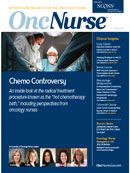Nonmyeloablative Conditioning Before Cell Transplantation Shows Potential in Older Patients With Hematologic Malignancies
Older patients with advanced hematologic malignancies who receive a minimally toxic nonmyeloablative regimen before allogeneic HCT have favorable OS and PFS rates.
Robert Morreale/Visual explanations, LLC
Older patients with advanced hematologic malignancies who receive a minimally toxic nonmyeloablative regimen before allogeneic hematopoietic cell transplantation (HCT) have favorable overall survival (OS) and progression-free survival (PFS) rates, according to the results of a recent study.
Mohammed L. Sorror, MD, with Fred Hutchinson Cancer Research Center, and colleagues examined outcomes in 372 patients who underwent conditioning with a low dose of total body irradiation either alone or combined with 90 mg/m2 of fludarabine prior to HCT. Postgrafting immunosuppression included mycophenolate mofetil plus a calcineurin inhibitor (cyclosporine or tacrolimus) in different schedules.
Subjects were aged 60 to 75 years with advanced hematologic malignancies who underwent HCT in multicenter prospective clinical trials from 1998 to 2008. The patients were divided into 3 groups according to age: 218 patients were aged 60 to 64 years, 121 patients were aged 65 to 69 years, and 33 patients were aged 70 to 75 years.
Nurses Perspective
Melissa Baker, RN, MSN, OCN®, APN-C Adult Blood & Marrow Stem Cell Transplantation Program John Theurer Cancer Center Hackensack, New Jersey
While the prevalence of most hematologic malignancies increases with age, advanced age has historically been a limiting factor to proceed with HCT. With the advent of nonmyeloablative conditioning regimens, patients who may have been previously excluded from HCT due to older age may now be eligible for transplant.
Sorror et al, report a 5-year survival rate of 35% with minimal organ toxicity. These results are encouraging, and may offer a potentially curable treatment to older adults who are ineligible for myeloablative conditioning regimens.
Older patients undergoing allogeneic HCT have different issues compared to younger patients. These include the number of comorbidities and its effects in terms of medication interactions; prescription coverage, as many of these patients have Medicare; and increased organ toxicity.
Utilization of a nonmyeloablative conditioning regimen addresses each of these issues, making it reasonable to consider HCT in patients otherwise ineligible. Evaluating patients and utilizing risk assessment strategies to determine functional age (compared to chronological age) may help predict which type of conditioning regimen is best suited for each individual.
The projected incidence of newly diagnosed hematologic malignancies is climbing; therefore, incorporating curative treatment options to a larger subset of this population is undoubtedly appealing. By broadening the eligibility criteria for HCT, future direction and possible changes made to healthcare policy may be necessary.
Irrespective of age, the 5-year OS and PFS rates were 35% (95% CI, 30%-40%) and 32% (95% CI, 27%-37%), respectively. The 5-year survival rates ranged from 23% (95% CI, 11%-35%) in patients who had high comorbidity burden, and high relapse risk to 69% (95% CI, 44%-95%) in patients with low comorbidity burden and low relapse risk. Also, half of these patients were never hospitalized, and two-thirds of survivors had eventual resolution of their chronic graft versus host disease with restoration of normal or near-normal physical function as demonstrated by their Karnofsky Performance Status scores.
Sorror and associates said that their findings are “encouraging,” especially with respect to relapse, considering the poor outcomes seen with nontransplantation treatments. They did note, however, that a major drawback of their study was the lack of a control group receiving standard therapy or supportive care.
Increasing age has long been blamed for the higher mortality after high-dose allogeneic HCT for patients with hematologic malignancies. The intense, cytotoxic conditioning regimens that precede transplantation are intended to decrease tumor burden but may cause organ toxicity. As a result, only younger, healthy patients have been deemed eligible for high-dose HCT.
A longstanding cutoff age of 55 to 60 years has meant that most patients with hematologic malignancies have been denied allogeneic HCT, given that hematologic malignancies are primarily diseases of the elderly, with the median age at diagnosis of most hematologic malignancies ranging from 65 to 70 years.
Also, the availability of good treatment options for older patients with advanced hematologic malignancies is becoming increasingly important. With current demographic trends, it is projected that 20% of the population will be aged 65 years or older within the next 2 decades, and also that the number of newly diagnosed hematologic malignancies in older populations will increase by 77%.
Reference
Sorror ML, Sandmaier BM, Storer BE, et al. Long-term outcomes among older patients following nonmyeloablative conditioning and allogeneic hematopoietic cell transplantation for advanced hematologic malignancies. JAMA. 2011;306(17):1874-1883.

Shared Model of Care Post-HCT Offers Safe Follow-Up, Reduces Patient Burden
Published: March 19th 2025 | Updated: March 19th 2025Alternating post-HCT care between specialized facilities and local cancer centers produced noninferior non-relapse mortality and similar quality of life to usual care.


